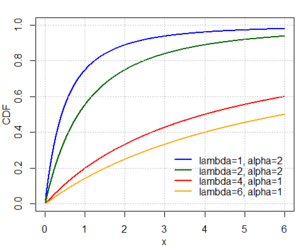Lomax distribution
|
Probability density function  | |
|
Cumulative distribution function  | |
| Parameters |
scale (real) |
|---|---|
| Support | |
| CDF | |
| Mean |
Otherwise undefined |
| Median | |
| Mode | 0 |
| Variance |
Otherwise undefined |
| Skewness | |
| Ex. kurtosis | |
The Lomax distribution, conditionally also called the Pareto Type II distribution, is a heavy-tail probability distribution used in business, economics, actuarial science, queueing theory and Internet traffic modeling.[1][2][3] It is named after K. S. Lomax. It is essentially a Pareto distribution that has been shifted so that its support begins at zero.[4]
Characterization
Probability density function
The probability density function (pdf) for the Lomax distribution is given by
with shape parameter and scale parameter . The density can be rewritten in such a way that more clearly shows the relation to the Pareto Type I distribution. That is:
- .
Non-central moments
The th non-central moment exists only if the shape parameter strictly exceeds , when the moment has the value
Related distributions
Relation to the Pareto distribution
The Lomax distribution is a Pareto Type I distribution shifted so that its support begins at zero. Specifically:
The Lomax distribution is a Pareto Type II distribution with xm=λ and μ=0:[5]
Relation to generalized Pareto distribution
The Lomax distribution is a special case of the generalized Pareto distribution. Specifically:
Relation to the beta prime distribution
The Lomax distribution with scale parameter λ = 1 is a special case of the beta prime distribution. If X has a Lomax distribution, then .
Relation to q-exponential distribution
The Lomax distribution is a special case of the q-exponential distribution. The q-exponential extends this distribution to support on a bounded interval. The Lomax parameters are given by:
Gamma-exponential mixture
The Lomax distribution arises as a mixture of exponential distributions where the mixing distribution of the rate is a gamma distribution. If λ|k,θ ~ Gamma(scale=k, shape=θ) and X|λ ~ Exponential(rate=λ) then the marginal distribution of X|k,θ is Lomax(scale=1/k, shape=θ).
See also
- Power law
- Hyperexponential distribution (finite mixture of exponentials)
References
- ↑ Lomax, K. S. (1954) "Business Failures; Another example of the analysis of failure data". Journal of the American Statistical Association, 49, 847–852. JSTOR 2281544
- ↑ Johnson, N. L.; Kotz, S.; Balakrishnan, N. (1994). "20 Pareto distributions". Continuous univariate distributions. 1 (2nd ed.). New York: Wiley. p. 573.
- ↑ J. Chen, J., Addie, R. G., Zukerman. M., Neame, T. D. (2015) "Performance Evaluation of a Queue Fed by a Poisson Lomax Burst Process", IEEE Communications Letters, 19, 3, 367-370.
- ↑ Van Hauwermeiren M and Vose D (2009). A Compendium of Distributions [ebook]. Vose Software, Ghent, Belgium. Available at www.vosesoftware.com. Accessed 07/07/11
- ↑ Kleiber, Christian; Kotz, Samuel (2003), Statistical Size Distributions in Economics and Actuarial Sciences, Wiley Series in Probability and Statistics, 470, John Wiley & Sons, p. 60, ISBN 9780471457169 .